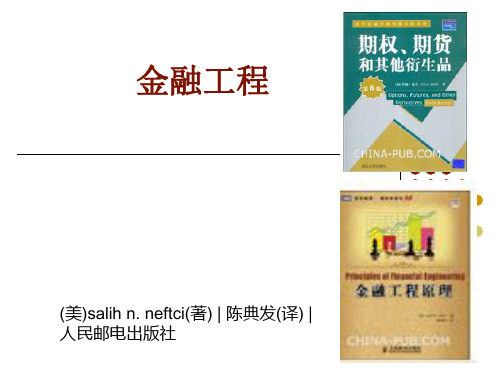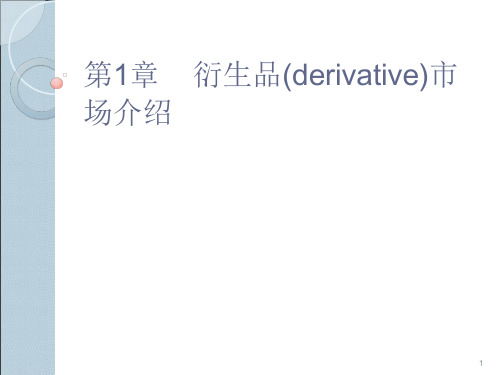期权、期货及其他衍生产品课件13金融工程学
合集下载
期货期权及其衍生品配套(全34章)Ch01PPT课件

详细描述
期货交易是一种衍生品交易,其基础资产可以是商品、外汇或股票等。交易双方 通过签订期货合约的方式,约定在未来某一特定时间和价格上交割指定数量的基 础资产。期货交易的主要目的是为了规避风险或进行套期保值。
期货交易规则与流程
总结词
期货交易具有严格的交易规则和流程, 包括保证金制度、逐日盯市、交割制度 等。
卖出看跌期权策略
当预期标的资产价格下跌时,卖出看 跌期权获得赚取收益的权利,但获得 权利金。
组合策略
跨式期权组合策略
同时买入相同行权价格的看涨和看跌 期权,以获得赚取收益的权利,但需 支付权利金。
宽跨式期权组合策略
同时买入不同行权价格的看涨和看跌 期权,以获得赚取收益的权利,但需 支付权利金。
06
04
Theta
衡量期权价格对Rho
衡量期权价格对无风险利率的敏感度。
风险度量与控制
风险度量
通过计算期权价格的敏感性指标,如Delta、 Gamma、Theta、Vega和Rho等,来评估 期权的风险敞口。
风险控制
通过设置止损点、动态调整持仓结构、使用 对冲策略等方式,降低或消除期权交易的风 险敞口。
期权风险管理
希腊字母及其应用
希腊字母
包括Delta、Gamma、Theta、Vega和Rho等, 用于描述期权价格变动与标的资产价格、波动
率、剩余到期时间等变量的敏感性。
01
Gamma
衡量Delta对标的资产价格的敏感度。
03
Vega
衡量期权价格对波动率的敏感度。
05
02
Delta
衡量标的资产价格变动对期权价格的影响程 度。
期货期权及其衍生品配套(全34章 )ch01ppt课件
期货交易是一种衍生品交易,其基础资产可以是商品、外汇或股票等。交易双方 通过签订期货合约的方式,约定在未来某一特定时间和价格上交割指定数量的基 础资产。期货交易的主要目的是为了规避风险或进行套期保值。
期货交易规则与流程
总结词
期货交易具有严格的交易规则和流程, 包括保证金制度、逐日盯市、交割制度 等。
卖出看跌期权策略
当预期标的资产价格下跌时,卖出看 跌期权获得赚取收益的权利,但获得 权利金。
组合策略
跨式期权组合策略
同时买入相同行权价格的看涨和看跌 期权,以获得赚取收益的权利,但需 支付权利金。
宽跨式期权组合策略
同时买入不同行权价格的看涨和看跌 期权,以获得赚取收益的权利,但需 支付权利金。
06
04
Theta
衡量期权价格对Rho
衡量期权价格对无风险利率的敏感度。
风险度量与控制
风险度量
通过计算期权价格的敏感性指标,如Delta、 Gamma、Theta、Vega和Rho等,来评估 期权的风险敞口。
风险控制
通过设置止损点、动态调整持仓结构、使用 对冲策略等方式,降低或消除期权交易的风 险敞口。
期权风险管理
希腊字母及其应用
希腊字母
包括Delta、Gamma、Theta、Vega和Rho等, 用于描述期权价格变动与标的资产价格、波动
率、剩余到期时间等变量的敏感性。
01
Gamma
衡量Delta对标的资产价格的敏感度。
03
Vega
衡量期权价格对波动率的敏感度。
05
02
Delta
衡量标的资产价格变动对期权价格的影响程 度。
期货期权及其衍生品配套(全34章 )ch01ppt课件
期权、期货及其他衍生产品课件1金融工程学

1.19
Borrow $300 at 5% for one year Buy one ounce of gold Enter into a short forward contract to sell the gold for $340 in one year 340-300-300×5%=$25
1.24
2. Oil: Another Arbitrage Opportunity?
Suppose that: - The spot price of oil is US$19 - The quoted 1-year futures price of oil is US$16 - The 1-year US$ interest rate is 5% per annum - The storage costs of oil are 2% per annum Is there an arbitrage opportunity?
1.14
Futures Contracts (page 6)
Agreement to buy or sell an asset for a certain price at a certain time Similar to forward contract Whereas a forward contract is traded OTC, a futures contract is traded on an exchange
金融工程
(美)salih n. neftci(著) | 陈典发(译) | 人民邮电出版社
1.1
Introduction
Chapter 1
1.2
The Nature of Derivatives
Borrow $300 at 5% for one year Buy one ounce of gold Enter into a short forward contract to sell the gold for $340 in one year 340-300-300×5%=$25
1.24
2. Oil: Another Arbitrage Opportunity?
Suppose that: - The spot price of oil is US$19 - The quoted 1-year futures price of oil is US$16 - The 1-year US$ interest rate is 5% per annum - The storage costs of oil are 2% per annum Is there an arbitrage opportunity?
1.14
Futures Contracts (page 6)
Agreement to buy or sell an asset for a certain price at a certain time Similar to forward contract Whereas a forward contract is traded OTC, a futures contract is traded on an exchange
金融工程
(美)salih n. neftci(著) | 陈典发(译) | 人民邮电出版社
1.1
Introduction
Chapter 1
1.2
The Nature of Derivatives
期权、期货及其他衍生证券PPT课件

03 期货基础知识
期货定义及分类
期货定义
期货是一种标准化合约,约定在未来某个特定时间和地点交 割一定数量和质量的标的物。
期货分类
根据标的物不同,期货可分为商品期货、金融期货和其他期 货。
期货合约要素
报价单位
交易单位
每份期货合约代表的交易数量, 如10吨大豆、1000桶原油等。
期货价格的计价单位,如元/吨、 美元/桶等。
期权合约要素
标的资产
期权合约中约定的买卖 对象,可以是股票、债
券、商品、外汇等。
行权价格
到期日
权利金
期权合约中约定的买卖 标的资产的价格。
期权合约的到期期限, 到期后期权将不再有效。
购买期权所需要支付的 费用,也就是期权的价
格。
期权价格影响因素
标的资产价格
行权价格
剩余到期时间
波动率
无风险利率
标的资产价格与期权价 格呈正相关关系,标的 资产价格上涨,则看涨 期权价格上涨,看跌期 权价格下跌;反之亦然 。
最小变动价位
期货价格变动的最小单位,如1元 /吨、0.01美元/桶等。
交易品种
期货合约规定了交易的具体品种, 如大豆、原油等。
每日价格最大波动限制
为了防止非理性过度波动,交易 所通常会对期货合约的每日价格 最大波动幅度进行限制。
期货价格影响因素
供求关系
当市场需求大于供应时,期货价格上 涨;反之,当市场供应大于需求时, 期货价格下跌。
适用范围
Black-Scholes模型适用于欧式期权和一些路径依赖程度不高的美式期权的定价和估值, 也可用于其他衍生证券的定价和风险管理。
06 衍生证券的风险管理
市场风险管理
期权、期货及其他衍生产品课件12金融工程学

Generalized Wiener Processes
(continued)
The variable x follows a generalized Wiener process with a drift rate of a and a variance rate of b2 if dx=a dt+b dz if dx=a dt x x0 at
Wiener Processes and Itô ’s Lemma
Chapter 12
Types of Stochastic Processes
Any variable whose value changes over time in an uncertain way is said to follow a stochastic process. Discrete time; discrete variable Discrete time; continuous variable Continuous time; discrete variable Continuous time; continuous variable
The Example
A stock price starts at 40 and has a probability distribution of f(40,10) at the end of the year If we assume the stochastic process is Markov with no drift then the process is dS = 10dz If the stock price were expected to grow by $8 on average during the year, so that the year-end distribution is f(48,10), the process would be dS = 8dt + 10dz
期货期权及其衍生品配套(全34章)Ch13PPT课件

期货期权的分类
总结词
期货期权的分类
详细描述
根据行权时间的不同,期货期权可以分为欧式期权和美式期权。欧式期权只能在 到期日行权,而美式期权可以在到期日之前的任何时间行权。
期货期权与股票期权的比较
总结词
期货期权与股票期权的比较
详细描述
与股票期权相比,期货期权具有以下特点:一是标的资产不同,期货期权的标的资产是期货合约,而股票期权的 标的资产是股票;二是风险和收益不同,期货期权的风险和收益相对较小,因为其行权价格是固定的,而股票期 权的行权价格是变动的,风险和收益相对较大。
02
用于计算期权价格的敏感性分析 ,如Delta、Gamma、Vega等。
Black-Scholes模型
Hale Waihona Puke 一种经典的期权定价模型,基于无套 利定价原理和随机过程理论。
假设标的资产价格服从几何布朗运动 ,并考虑了标的资产收益、无风险利 率、行权价格、到期时间等因素对期 权价格的影响。
04
期权市场的监管与法规
和规章,维护市场秩序,保障投资者权益。
期权交易的法规要求
实名制开户
保证金制度
投资者在进行期权交易前,需在证券或期 货公司进行实名制开户,并提供身份证明 、联系方式等必要信息。
期权交易实行保证金制度,投资者需按照 规定的保证金比例缴纳保证金,以降低市 场风险。
限仓制度
价格波动限制
为了防止市场操纵和过度投机,期权交易 实行限仓制度,对每个投资者的持仓数量 进行限制。
并降低单一期权的风险。
卖出跨式期权案例
总结词
赚取权利金并降低风险
详细描述
卖出跨式期权是指同时卖出相同标的资产、 到期日相同、行权价格不同的看涨期权和看 跌期权。通过卖出跨式期权,投资者可以获 得赚取权利金的机会,并降低单一期权的风 险。在市场价格波动较大时,卖出跨式期权 可获得更多的权利金收入。
期货与期权PPT课件

期货市场的交易品种
总结词
期货市场的交易品种包括商品期货、金融期货和股指期货等。
详细描述
商品期货是最早的期货品种,包括农产品、金属、能源等实物商品。金融期货是衍生品市场的主体,包括利率、 汇率、债券等。股指期货则是以股票指数为标的物的期货合约。这些品种的期货合约具有不同的特点和风险收益 特征,为投资者提供了多样化的选择。
03
期权市场
期权市场的定义与特点
定义
期权市场是买卖期权合约的场所,期权合约是一种金融衍生品合约,赋予买方在 规定期限内按照约定价格买入或卖出标的资产的权利。
特点
期权市场具有高杠杆、低风险、灵活性强等优点,为投资者提供了规避风险和获 取收益的途径。
期权市场的交易品种
按标的资产分类
股票期权、期货期权、外汇期权、利率期权等。
详细描述
期货市场是由买卖双方聚集在一起,按照公开、公平 、公正的原则进行期货合约交易的场所。期货合约是 标准化的,规定了商品的质量、数量、交割时间和地 点等条款。在期货交易中,买方和卖方都需要缴纳一 定比例的保证金,以确保合约履行的可靠性。期货市 场允许买空卖空操作,即双向交易。交易价格是通过 集中竞价形成的,反映了市场供求关系和参与者的预 期。
期货市场的交易制度
总结词
期货市场的交易制度包括保证金制度、逐日盯市制度 、持仓限额制度和大户报告制度等。
详细描述
保证金制度是期货市场的基础制度之一,要求买卖双方 按照规定缴纳一定比例的保证金,以降低违约风险。逐 日盯市制度是指每个交易日结束后,对所有未平仓合约 进行盈亏结算,以控制风险。持仓限额制度和大户报告 制度则是为了防止市场操纵和过度投机而设立的制度, 限制了单个投资者或机构的持仓数量和规模。这些制度 的设立有助于维护市场的公平和稳定。
十一讲期货期权与其他衍生工具市场PPT学习教案

仓(Open) 平 仓:买入后卖出, 或卖出后买入结算原先所做的
新单 单 号:系统为委托单或成交单分配的唯一标识
第11页/共29页
期货与期权(12)
第12页/共29页
期货与期权(13)
期货交割价格的合成:机会成本定价或套利定价。 100盎司的黄金,即期价格:每盎司$400。 一位买家想在三个月后买,价格是多少? 100盎司黄金三个月的储藏和保险的金额:$5+$10=$15; 放弃的三个月的利息:40000@2%=$800; $40000+$800+$15=$40815 每盎司黄金$408.15。 在即期价格和期货价格间的价差反映了利息、储存和
机构、个人,只要存在与利率、汇率和价格波动相关的风险 暴露,都可能是期货市场的潜在保值者;同时投机者也不断 增多。
第2页/共29页
期货与期权(3)
期货合约的买方:同意按既定价格在未来购买某种基础商品的一 方,在交易中被称为多头(long position)或称为做多(long futures)。
第10页/共29页
期货与期权(11)
买 价:某商品当前最高申报买入价 卖 价:某商品当前最低申报卖出价 涨跌幅:某商品当日收盘价与昨日结算价之间的价差 涨停板额:某商品当日可输入的最高限价(等于昨结
算价+最大变动幅度) 跌停板额:某商品当日可输入的最低限价(等于昨结
算价—最大变幅) 空盘量:当前某商品未平仓合约总量 开 仓:只做了买入卖出双向操作中的一项, 即开新
头寸进行清算 。 平仓:轧平头寸。为了达到平仓的目的,期货合约的交易者必须在合约到期
前对同样的合约做一笔相反的交易以冲销手中的头寸。合约的买方需要卖出 同等数量的相同的期货合约,而卖方则要买入一笔同等数量的相同的合约。 实物交割:即期货合约的买方按既定价格买入某种基础工具,卖方要按既定 的价格卖出基础工具。
新单 单 号:系统为委托单或成交单分配的唯一标识
第11页/共29页
期货与期权(12)
第12页/共29页
期货与期权(13)
期货交割价格的合成:机会成本定价或套利定价。 100盎司的黄金,即期价格:每盎司$400。 一位买家想在三个月后买,价格是多少? 100盎司黄金三个月的储藏和保险的金额:$5+$10=$15; 放弃的三个月的利息:40000@2%=$800; $40000+$800+$15=$40815 每盎司黄金$408.15。 在即期价格和期货价格间的价差反映了利息、储存和
机构、个人,只要存在与利率、汇率和价格波动相关的风险 暴露,都可能是期货市场的潜在保值者;同时投机者也不断 增多。
第2页/共29页
期货与期权(3)
期货合约的买方:同意按既定价格在未来购买某种基础商品的一 方,在交易中被称为多头(long position)或称为做多(long futures)。
第10页/共29页
期货与期权(11)
买 价:某商品当前最高申报买入价 卖 价:某商品当前最低申报卖出价 涨跌幅:某商品当日收盘价与昨日结算价之间的价差 涨停板额:某商品当日可输入的最高限价(等于昨结
算价+最大变动幅度) 跌停板额:某商品当日可输入的最低限价(等于昨结
算价—最大变幅) 空盘量:当前某商品未平仓合约总量 开 仓:只做了买入卖出双向操作中的一项, 即开新
头寸进行清算 。 平仓:轧平头寸。为了达到平仓的目的,期货合约的交易者必须在合约到期
前对同样的合约做一笔相反的交易以冲销手中的头寸。合约的买方需要卖出 同等数量的相同的期货合约,而卖方则要买入一笔同等数量的相同的合约。 实物交割:即期货合约的买方按既定价格买入某种基础工具,卖方要按既定 的价格卖出基础工具。
第十二章 期权定价理论 《金融工程学》PPT课件

➢ 由于方程中不存在风险偏好,那么风险将不会对其解产生影响,因此 在对期权进行定价时,可以使用任何一种风险偏好,甚至可以提出一 个非常简单的假设:所有投资者都是风险中性的
12.2布莱克—斯科尔斯(B-S)模型
(6)Black-Scholes期权定价公式 Black-Scholes微分方程,对于不同的标的变量 S 的不同衍生证券,会 有许多解,解这个方程时得到的特定衍生证券的定价公式 f 取决于使用 的边界条件,对于股票的欧式看涨期权,关键的边界条件为: f=Max(ST-K,0) (12—28) 由风险中性可知,欧式看涨期权的价格C是期望值的无风险利率贴现的
第12章 期权定价理论
12.1 期权价格概述
➢ 12.1.1期权定价概述
➢ 在所有的金融工程工具中,期权是一种非常独特的工具。因为期 权给予买方一种权利,使买方既可以避免不利风险又可以保留有 利风险,所以期权是防范金融风险的最理想工具。但要获得期权 这种有利无弊的工具,就必须支付一定的费用,即期权价格
一定的假设条件下得到的,这些条件包括:股票价格满足布朗运动;
股票的收益率服从正态分布;期权的有效期内不付红利。该公式的不
足之处是它允许有负的股票价格和期权价格,这显然和实际是不相符
合的,而且该公式没有考虑货币的时间价值。由于其理论的不完备,
计算结果的不准确,再加上当时市场的不发达,因此该定价公式在当
N(d)=
1
d
e
x2
2
dx
2
(12—3)
这些公式都应有以下假设: (1)没有交易费。 (2)可以按无风险利率借入或贷出资金
12.2布莱克—斯科尔斯(B-S)模型
➢ 对期权的定价理论进行开创性研究的学者是法国的Bachelier。1900
期货期权及其衍生品配套课件Ch13

Options, Futures, and Other Derivatives, 7th International
Edition, Copyright © John C. Hull 2019
4
Continuously Compounded Return
Equations 13.6 and 13.7), page 279)
Options, Futures, and Other Derivatives, 7th International
Edition, Copyright © John C. Hull 2019
9
Estimating Volatility from Historical Data (page 282-84)
Edition, Copyright © John C. Hull 2019
5
The Expected Return
The expected value of the stock price is S0emT The expected return on the stock is m – s2/2 not m
Edition, Copyright © John C. Hull 2019
10
Nature of Volatility
Volatility is usually much greater when the market is open (i.e. the asset is trading) than when it is closed For this reason time is usually measured in “trading days” not calendar days when options are valued
期权期货与金融衍生品PPT学习教案

最佳的套期率为
第29页/共39页
我们的建议
•购买远期或 期货
Click to add Title
•购买看涨期权
第30页/共39页
卖出看跌期权 (基于原有合 约的修正)
购买远期或期货
远期或期货
签订远期合约
购买石油期货
优点:交易对手易寻 流动性较好
优点:
缺点:
缺点:财务压力大 (保证金)
可协 商性
•流动性 风险
第27页/共39页
深南电所签的期权合约存在如下问题
2
虽然燃油价格以及燃料成本下降能够 弥补深 南电的 期权合 约支出 ,但期 权合约 支出也 部分的 抵消了 燃料成 本下降 带来的 收益, 并且抵 消程度 超过了 合约收 入对燃 油价格 增加的 补偿程 度。
假设燃油价格下跌到P(P) 深南电每月需要向杰润公司支付的金 额为(62-P)* 40 由于价格下降的支出节约(62-P)*52.42 期权合约支出抵消了燃料成本下降带 来的收 益程度 (62-P)*40/
历史上对战略资源的争夺始终非常激 烈,战 争、能 源外交 、政局 动荡、 罢工事 件等地 缘政治 风险都 会影响 到资源 的获取 。
金融属性
•
供求关系决定着油价的基本走向,石 油的金 融属性 对油价 剧烈波 动起到 了非常 重要的 推波助 澜作用 ;美元 币值的 变化对 油价的 影响。
第10页/共39页
第20页共39页高盛角度高盛角度两个角色两个角色合约设计及油价预测者由高盛的销售及研究部门扮演投机者由高盛旗下的专事提第21页共39页合约对赌方及投机者合约对赌方及投机者以低价购买看跌期权两份合约中的互为反向的标的份额上的微妙变化旗下的对冲基金在其中也有获利作为一个顶级投行完全可能设计另一个合约来对冲风险第22页共39页在油价的高点由多转空达到最终收益合约设计及油价预测者合约设计及油价预测者第23页共39页对于看跌期权的估值对于看跌期权的估值采取采取blaskblaskscholesscholes模型模型进行分析进行分析第24页共39页blaskblaskscholesscholes模型进行模型进行分析分析其中其中kk为行权价为行权价ff为现货价为现货价tt为距离行为距离行权日的时间权日的时间为波动率
期权,期货与其他金融衍生品幻灯片PPT

The forward price may be different for contracts of different maturities (as shown by the table)
Options, Futures, and Other Derivatives, 8th Edition,
Copyright © John C. Hull 2012
Copyright © John C. Hull 2012
11
Profit from a Long Forward Position (K= delivery price=forward
price at time contract is entered into)
Profit
Price of Underlying at
期权,期货与其他金融衍生 品幻灯片PPT
本课件PPT仅供大家学习使用 学习完请自行删除,谢谢! 本课件PPT仅供大家学习使用 学习完请自行删除,谢谢! 本课件PPT仅供大家学习使用 学习完请自行删除,谢谢! 本课件PPT仅供大家学习使用 学习完请自行删除,谢谢!
What is a Derivative?
at time contract is entered into)
Profit
Price of Underlying
K
at Maturity, ST
Options, Futures, and Other Derivatives, 8th Edition,
Copyright © John C. Hull 2012
The real options approach to assessing capital investment decisions has become widely accepted
Options, Futures, and Other Derivatives, 8th Edition,
Copyright © John C. Hull 2012
Copyright © John C. Hull 2012
11
Profit from a Long Forward Position (K= delivery price=forward
price at time contract is entered into)
Profit
Price of Underlying at
期权,期货与其他金融衍生 品幻灯片PPT
本课件PPT仅供大家学习使用 学习完请自行删除,谢谢! 本课件PPT仅供大家学习使用 学习完请自行删除,谢谢! 本课件PPT仅供大家学习使用 学习完请自行删除,谢谢! 本课件PPT仅供大家学习使用 学习完请自行删除,谢谢!
What is a Derivative?
at time contract is entered into)
Profit
Price of Underlying
K
at Maturity, ST
Options, Futures, and Other Derivatives, 8th Edition,
Copyright © John C. Hull 2012
The real options approach to assessing capital investment decisions has become widely accepted
第十四章 期权品种 《金融工程学》PPT课件

14.2 利率期权
➢ (2)利率期权的功能
➢ 利率期权是一项规避短期利率风险的有效工具。借款人通过买入 一项利率期权,可以在利率水平向不利方向变化时得到保护,而 在利率水平向有利方向变化时得益
14.2 利率期权
➢ 2)利率期权的产生与发展
➢ 澳大利亚悉尼期货交易所于1982年3月把期权交易运用到银行票据 期货市场,这是利率期权的开端
14.1 货币期权
➢ (2)其他术语
➢ ④平价。如果期权的履约价格(即合同价格)等于当时的即期汇 率,称为即期平价。如果履约价格等于当时对应的远期汇价,称 为远期平价。比如,3个月期的期权履约价格与3个月期的远期汇 率都是1.7200(GBP/USD)。
➢ ⑤折价。对于期权的持有者来说,当履约价格(比如1.6500的GBP 看跌期权)优于即期汇率(比如1.8500)时,即为即期折价。对 于远期折价亦然。
➢ 四是协定价格的选择更灵活
14.1 货币期权
➢ 4)交易场所及交易币种
➢ (1)交易场所
➢ 世界上主要的货币期权交易所为美国的费城股票交易所(Philade lphia Stock Exchange,PHLX)、芝加哥期权交易所(Chicago B oard Options Exchange,CBOE)、芝加哥商品交易所(Chicago Mercantile Exchange,CME)、伦敦国际金融期货交易所(Londo n International Financial Future Exchange,LIFFE)、荷兰 阿姆斯特丹的欧洲期权交易所(European Options Exchange)、 伦敦股票交易所(London Stock Exchange)、澳大利亚悉尼期货 交易所(Sydney Future Exchange)和新加坡国际货币交易所(S ingapore International Monetary Exchange,SIMEX)
25_期权期货及其他衍生品第一章课件

15.00
Oct Call
4.650
Jan Call
4.950
Apr Call
5.150
Oct Put
0.025
Jan Put
17.50 2.300 2.775 3.150 0.125 0.475 0.725
20.00 0.575 1.175 1.650 0.875 1.375 1.700
5
远期价格(forward price)
• 远期价格(forward price)定义为使得远期合约 价值为零的交割价格。
为什么是合约价值为零情况下的交割价格? 如果市场出现合约价值不是零的交割时,会发
生什么呢?
6
1. 黄金市场: 是否有套利的机 会?
假定: 黄金的现货价格是900美元每盎司 一年期黄金远期价格是1020美元每盎 司 一年期美元利率是5%
17
期权 vs 期货/远期
• 期货/远期合约赋予持有者以一定的价格购买 或卖出某种资产
• 期权合约给予持有者以一定价格购买或卖出 某种资产的权利
18
交易者的类型
•对冲者(hedgers) • 投机者(speculators) • 套利者(arbitrageurs)
衍生品交易过程中的巨额亏损有时是因为有些对冲交易 者和套利交易者转变为投机交易者 (比如英国巴林银行 的破产)
• 与远期合约不同的是:1)场内交易;2)合约 标准化;3)交割日期。
• 期货价格取决供需双方
11
全球主要期货交易所
• Chicago Board of Trade • Chicago Mercantile Exchange • LIFFE (London) • Eurex (Europe) • BM&F (Sao Paulo, Brazil) • TIFFE (Tokyo) • 其它的列在课本后面
Oct Call
4.650
Jan Call
4.950
Apr Call
5.150
Oct Put
0.025
Jan Put
17.50 2.300 2.775 3.150 0.125 0.475 0.725
20.00 0.575 1.175 1.650 0.875 1.375 1.700
5
远期价格(forward price)
• 远期价格(forward price)定义为使得远期合约 价值为零的交割价格。
为什么是合约价值为零情况下的交割价格? 如果市场出现合约价值不是零的交割时,会发
生什么呢?
6
1. 黄金市场: 是否有套利的机 会?
假定: 黄金的现货价格是900美元每盎司 一年期黄金远期价格是1020美元每盎 司 一年期美元利率是5%
17
期权 vs 期货/远期
• 期货/远期合约赋予持有者以一定的价格购买 或卖出某种资产
• 期权合约给予持有者以一定价格购买或卖出 某种资产的权利
18
交易者的类型
•对冲者(hedgers) • 投机者(speculators) • 套利者(arbitrageurs)
衍生品交易过程中的巨额亏损有时是因为有些对冲交易 者和套利交易者转变为投机交易者 (比如英国巴林银行 的破产)
• 与远期合约不同的是:1)场内交易;2)合约 标准化;3)交割日期。
• 期货价格取决供需双方
11
全球主要期货交易所
• Chicago Board of Trade • Chicago Mercantile Exchange • LIFFE (London) • Eurex (Europe) • BM&F (Sao Paulo, Brazil) • TIFFE (Tokyo) • 其它的列在课本后面
期权、期货及其他衍生产品课件13金融工程学36页PPT

期权、期货及其他衍生产品课件13金 融工程学
36、如果我们国家的法律中只有某种 神灵, 而不是 殚精竭 虑将神 灵揉进 宪法, 总体上 来说, 法律就 会更好 。—— 马克·吐 温 37、纲纪废弃之日,便是暴政兴起之 时。—的支持,法律 是丝毫 没有力 量的。 ——菲 力普斯 39、一个判例造出另一个判例,它们 迅速累 聚,进 而变成 法律。 ——朱 尼厄斯
40、人类法律,事物有规律,这是不 容忽视 的。— —爱献 生
61、奢侈是舒适的,否则就不是奢侈 。——CocoCha nel 62、少而好学,如日出之阳;壮而好学 ,如日 中之光 ;志而 好学, 如炳烛 之光。 ——刘 向 63、三军可夺帅也,匹夫不可夺志也。 ——孔 丘 64、人生就是学校。在那里,与其说好 的教师 是幸福 ,不如 说好的 教师是 不幸。 ——海 贝尔 65、接受挑战,就可以享受胜利的喜悦 。——杰纳勒 尔·乔治·S·巴顿
谢谢!
36、如果我们国家的法律中只有某种 神灵, 而不是 殚精竭 虑将神 灵揉进 宪法, 总体上 来说, 法律就 会更好 。—— 马克·吐 温 37、纲纪废弃之日,便是暴政兴起之 时。—的支持,法律 是丝毫 没有力 量的。 ——菲 力普斯 39、一个判例造出另一个判例,它们 迅速累 聚,进 而变成 法律。 ——朱 尼厄斯
40、人类法律,事物有规律,这是不 容忽视 的。— —爱献 生
61、奢侈是舒适的,否则就不是奢侈 。——CocoCha nel 62、少而好学,如日出之阳;壮而好学 ,如日 中之光 ;志而 好学, 如炳烛 之光。 ——刘 向 63、三军可夺帅也,匹夫不可夺志也。 ——孔 丘 64、人生就是学校。在那里,与其说好 的教师 是幸福 ,不如 说好的 教师是 不幸。 ——海 贝尔 65、接受挑战,就可以享受胜利的喜悦 。——杰纳勒 尔·乔治·S·巴顿
谢谢!
期货期权ppt课件

04
期货期权的实际应用
期货期权在风险管理中的应用
风险对冲
通过购买期货期权,投资者可以 对冲未来期货价格不利变动的风
险。
降低保证金要求
持有期货期权可以降低对期货合约 的保证金要求,从而降低资金成本 。
价格波动风险管理
期货期权可以为投资者提供一种管 理价格波动风险的方式,通过购买 或卖出期权,投资者可以控制风险 敞口。
通过调整Delta值来控制期货期权的风险敞口,Delta值表示标的 资产价格变动一个单位时,期权价值的变动量。
Gamma风险管理
关注标的资产价。
Vega风险管理
衡量标的资产波动率变动对期权价值的影响,通过调整Vega值来 管理风险。
期货期权的投资策略
期货期权市场的监管
法律法规监管
制定相关法律法规,规范市场行为,保护投 资者权益。
监管机构监管
对市场进行宏观调控,防止市场操纵和过度 投机。
交易所自律监管
交易所制定交易规则,对违规行为进行惩罚 。
信息披露与透明度监管
要求市场参与者及时披露相关信息,提高市 场透明度。
03
期货期权的定价与风险
期货期权的定价模型
随着信息技术的发展,国际期货期权市场电子化 交易趋势明显,自动化交易、算法交易等方式逐 渐成为主流。
中国期货期权市场的发展前景
政策支持力度加大
随着中国金融市场的逐步开放和政策的支持力度加大,中国期货 期权市场将迎来更大的发展空间。
投资者基础不断扩大
随着中国经济的发展和投资者的增多,期货期权市场的投资者基 础不断扩大,将进一步推动市场的发展。
二叉树模型
蒙特卡洛模拟
一种常用的期货期权定价模型,通过 模拟标的资产价格的上升和下降来计 算期权价值。
《期货与期权》课件

买入期权策略
买入看涨期权策略
当预期某资产价格上涨时,买入相应 的看涨期权,获得赚取收益的权利。
买入看跌期权策略
当预期某资产价格下跌时,买入相应 的看跌期权,获得赚取收益的权利。
卖出期权策略
卖出看涨期权策略
当预期某资产价格下跌时,卖出相应 的看涨期权,获得赚取收益的权利。
卖出看跌期权策略
当预期某资产价格上涨时,卖出相应 的看跌期权,获得赚取收益的权利。
详细描述
在期权交易中,风险识别与评估是至关重要 的步骤。这包括识别市场风险、信用风险、 流动性风险等,并评估这些风险的潜在影响 。通过了解每种风险的性质和影响,交易者
可以更好地制定风险管理策略。
风险控制与防范
总结词
采取一系列措施来控制和防范期权交易中的风险,以降低潜在损失并提高收益稳定性。
详细描述
总结词
通过研究影响期货价格的基本因素,如供求关系、宏观经济、政策法规等,对期 货价格进行预测和分析的方法。
详细描述
基本面分析主要关注影响期货价格的基本因素,包括供求关系、宏观经济指标、 政策法规、国际政治经济形势等。通过对这些因素的综合分析,投资者可以判断 未来期货价格的走势,并制定相应的投资策略。
每日结算制度
期货交易实行每日结算制度,即 当日盈亏在每个交易日结束时进 行结算,并相应调整保证金。
涨跌停板制度
为控制市场风险,期货交易所会 设定涨跌停板制度,限制每日价 格波动幅度。
期货交易的规则
买卖方向
01
期货交易的买卖方向与现货市场相反,即买方获得商品所有权
,卖方获得资金。
交易单位
02
期货交易通常以标准化的NKS
感谢观看
期货市场的作用主要体现在以下几个方面:一是为参与者提供转移风险和投机的机会,促进资源的合 理配置;二是为国民经济提供预警指标,为国家制定宏观经济政策提供参考;三是促进国际贸易的发 展,为进出口商提供规避汇率风险的工具。
- 1、下载文档前请自行甄别文档内容的完整性,平台不提供额外的编辑、内容补充、找答案等附加服务。
- 2、"仅部分预览"的文档,不可在线预览部分如存在完整性等问题,可反馈申请退款(可完整预览的文档不适用该条件!)。
- 3、如文档侵犯您的权益,请联系客服反馈,我们会尽快为您处理(人工客服工作时间:9:00-18:30)。
13.14
The Derivation of the Black-Scholes Differential Equation continued
The value of the portfolio is given by
ƒ f S S
The change in its value in time Dt is given by
DS mDt , s Dt S
where m is expected return and s is volatility
13.2
The Lognormal Property
(Equations 13.2 and 13.3, page 282)
It follows from this assumption that
This is because
ln[E(ST / S0 )]
are not the same
and
E[ln(ST / S0 )]
13.6
ln(S0 ) mT E ln(ST ) mT E ln(ST / S0 )
1 ST x= ln T S0
13.7
m and m−s2/2
c0
13.21
13.19
Properties of Black-Scholes Formula
As S0 becomes very large c tends to S0– Ke-rT and p tends to zero As S0 becomes very small c tends to zero and p tends to Ke-rT – S0 What happens when the volatility s approaches zero?
ST S0 e or
xT
ST 1 x = ln T S0 or x s2 m , 2
s2 ln ST ln S0 ~ m T , s T 2
s
T
13.5
The Expected Return
The expected value of the stock price is S0emT The expected return on the stock is m – s2/2 not m
13.13
The Derivation of the Black-Scholes Differential Equation
DS mS Dt sS Dz ƒ ƒ 2 ƒ 2 2 ƒ Dƒ S mS t ½ S 2 s S Dt S sS Dz We set up a portfolio consisting of 1 : derivative ƒ + : shares S
13.8
Mutual Fund Returns (See Business
Snapshot 13.1 on page 285)
Suppose that returns in successive years are 15%, 20%, 30%, -20% and 25% The arithmetic mean of the returns is 14% (15%+20%+30%-20%+25%)/5=14% The returned that would actually be earned over the five years (the geometric mean) is 12.4% 1*1.15*1.2*1.3*0.8*1.25=1*1.1245
S
If a stock price is $50 and its volatility is 25% per year what is the standard deviation of the price change in one day? 1
25% 252
13.10
Estimating Volatility from Historical Data (page 286-88)
ƒ = S – K e–r (T – t ) f f 1 2 2 2f rS s S rf 2 t S 2 S
13.17
The Black-Scholes Formulas
(See pages 295-297)
c S 0 N (d1 ) K e pKe
rT
rT
f f 1 2 2 f rS s S rf 2 t S 2 S
2
13.16
The Differential Equation
Any security whose price is dependent on the stock price satisfies the differential equation The particular security being valued is determined by the boundary conditions of the differential equation In a forward contract the boundary condition is ƒ = S – K when t =T The solution to the equation is
13.12
The Concepts Underlying BlackScholesce and the stock price depend on the same underlying source of uncertainty We can form a portfolio consisting of the stock and the option which eliminates this source of uncertainty The portfolio is instantaneously riskless and must instantaneously earn the risk-free rate This leads to the Black-Scholes differential equation
N(x) is the probability that a normally distributed variable with a mean of zero and a standard deviation of 1 is less than x See tables at the end of the book
13.3
The Lognormal Distribution
0
E ( ST ) S0 e mT var( ST ) S 0 e
2 2 mT
(e
s 2T
1)
Continuously Compounded Return, x
Equations 13.6 and 13.7), page 283)
13.20
The stock price will grow at rate r, at time T the payoff from a call option is Discounting at rate r, the value of the call today is consider consider
s2 ln ST ln S0 ~ m 2 or s2 ln ST ~ ln S0 m 2 T , s T T , s T
Since the logarithm of ST is normal, ST is lognormally distributed
Suppose we have daily data for a period of several months m is the average of the returns in each day [=E(DS/S)] m−s2/2 is the expected return over the whole period covered by the data measured with continuous compounding (or daily compounding, which is almost the same)
N (d 2 )
N (d 2 ) S 0 N (d1 )
2 ln( S 0 / K ) (r s / 2)T where d1 s T 2 ln( S 0 / K ) (r s / 2)T d2 d1 s T s T
13.18
The N(x) Function
13.9
The Volatility
s2 s x m , 2 T
The volatility is the standard deviation of the continuously compounded rate of return in 1 year The standard deviation of the return in time Dt is s Dt DS mDt , s Dt
3. 4.
t
S0
Calculate the standard deviation, s , of the ui´s The historical volatility estimate is: s
t
ˆ s
t
13.11
S1
S2
Sn
Nature of Volatility
